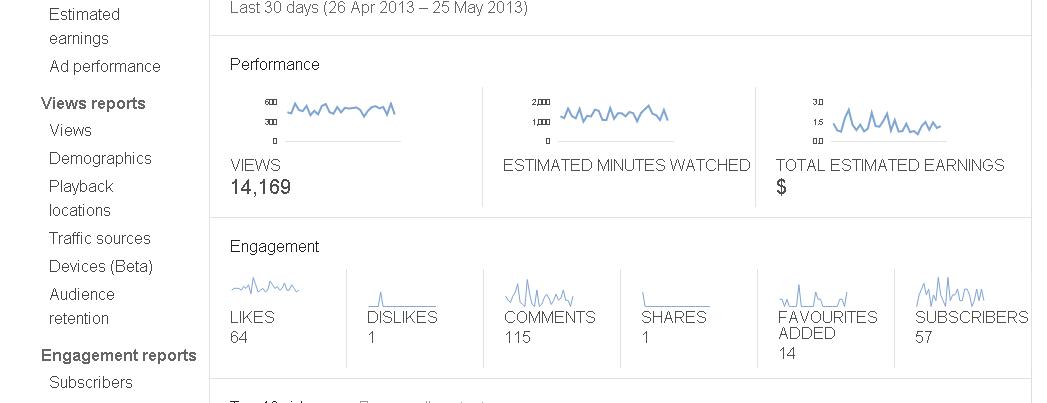Finding web video’s pot of gold
It is surely the golden dream of many a video producer; not only to spend time making videos but then to get paid for it as well. The traditional route – get a job in media and accept a salary cheque – is both hard fought and not necessarily well recompensed. The alternative, of self-publishing on the web with zero barrier to entry seems appealing. But can you actually do it?
Making a little money off the web is easy. YouTube offers pretty much anyone the chance to “monetize” – there’s an awful word – their content just by clicking a button. Doing so puts adverts both ahead of the video (so-called “pre rolls”) and overlaid onto the video (the ad banners we’ve all seen on the bottom of the YouTube playback window), and for each one that’s viewed or clicked, YouTube gets paid and the video creator gets a share. Get a video with a few thousand views and some of that audience is bound to click on the ads or watch them long enough for it to count as a paid view.
The sums, however, are not vast unless your views are too. Estimates vary wildly depending on which source you read but if you’re getting $1 USD for each thousand views then that seems to be reasonably good. Thus, if you’re one of the most popular YouTubers with a million views per video, that’s $1,000. Do one of those a week and you’ve got $52,000 a year which is not to be sneezed at – but who of us can truly say we get a million views per episode? In truth, few can.

Thus the opening sentence of the prior-but-one paragraph: making a LITTLE money off YouTube is easy, in the order of a few tens of dollars a month provided you have content which people want to see. Making LOTS of money is much harder.
Comedy skits and personal “vlogs” (shudder) are some of the most popular channels and the benefit of these is not just the immediate cash return from YouTube advertising but the spin-off which the popularity enables. In other words, you should be able to lever the view count into spin-off cash such as selling T-shirts and similar fan apparel and trinkets. You may also find yourself in demand as a personality to speak about your online success and be able to charge for that. Such dizzy accolades are really only for the mega-successful though, so again, making money all comes down to the numbers. That’s commercial television for you.. the medium may change but the business doesn’t.
Where else then, for the gold-hunting video producer to turn? If you’re more of a film-maker than a vlogger then perhaps Vimeo is the outlet for you. Long established as the outlet of choice for the more discerning online videomaker, Vimeo offers producers two methods to cash in.
First, you can simply ask viewers to donate using a “tip jar” mechanism on the site, operated by PayPal. You may laugh but amongst the Vimeo community – which is an equally discerning clientele, less interested in hilarious cats playing pianos and more interested in really good productions – donating to videos that they have enjoyed is not so far fetched. It does rely on your video being really good or really useful to the viewer – and on that viewer being so pleased as to put their hand in their pocket.

It should be noted that TipJar is only available on the Vimeo website itself, not where the videos are embedded on other sites, and you have to become a Vimeo Plus member to enable it, which is $9.95 a month or $59.95 per year if paid in advance. Here then, the economics are a gamble and it may be best to regard tips as a simple bonus rather than a sensible mechanism to make cash.
Should that not appeal, Vimeo also provides a pure ‘on-demand’ payment mechanism designed for longer form and regularly produced content (ie films and series). You have to join Vimeo Pro to get this function – $199 a year – but if you’re serious about selling then that fee should be negligible in the overall scheme of things.
Both of Vimeo’s schemes operate through PayPal which is a potential barrier to entry – there are many who dislike the service and many with horror stories about it – and it takes a cut of your income, of course. Naturally, Vimeo also takes a cut (15% for TipJar payments; 10% plus transaction fees ranging from 4% to 17% for on-demand).
So, we’ve done YouTube and Vimeo. Where else is there to see your creative endeavours turned to cold hard cash?
Well, DailyMotion.com also has a rewards scheme. Their Motionmaker plan is an official “tick” on your account to show that you’re genuinely uploading original content but one of the benefits is the option to enable adverts which you then share the revenue from. And there’s another way to get some cash from this site too which doesn’t even require you to make any videos: merely embedding your choice of their videos onto your website and signing up to DailyMotion Publisher means you get a trickle of money from the ads shown before the videos. You can add them to an everyday website, a blog, a Facebook page – anywhere the video can be shared.

Of course, DailyMotion is substantially less viewed than YouTube so popping your videos there and hoping for wads of ad-share cash is probably a forlorn hope. However, it is at least another string to your bow in the quiver of cashflow possibilities.
If merely getting a percentage of ad revenue is causing you to lose sleep then perhaps you need to go to the next level and consider selling sponsorship and advertising yourself. That way you keep all the money but of course you have to do the hard work of selling. In order for this to work, you’re going to need to have already built a substantial regular audience which you can prove to the potential sponsors.
It’s best if that audience has a single, definable interest such as a sailing boats or stamp collecting or mobile phone technology, or whatever. That way you can target exactly the advertisers who will be keen to reach that audience and they will be interested in what you have to say. Do check, however, that the terms of your video host don’t prohibit you adding your own sponsorship messages into the video.
Once you’ve exhausted the possibilities of advertising or revenue shares via whichever hosts you put your video onto, it’s time to spread your wings into other cash-generating opportunities. We’ve already mentioned spin-off merchandise but you don’t have to be an internet ‘personality’ (often dubious, at best) to gain a little offline traction from your video. Affiliate sales is the obvious option – companies such as Amazon offer a simple sign-up and customisable storefronts which you can then embed onto your own website (or indeed, put your links on other people’s sites, much to their fury).
For each sale made via your links, you get a small percentage kickback. Given enough traffic to your website, this could provide a handy extra income, depending on the value of the goods being purchased. Amazon isn’t the only one doing this by a long way but it’s the best known.
Whatever methods you choose to try to get some money from your videos, good luck and remember it will take time and much more effort than you may imagine. Building an audience is not an immediate process nor is it an instant route to financial success. Be patient though and your efforts should reap some reward.